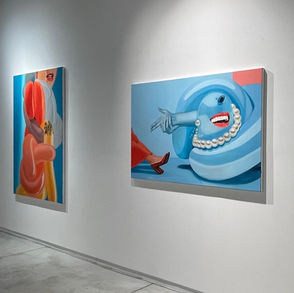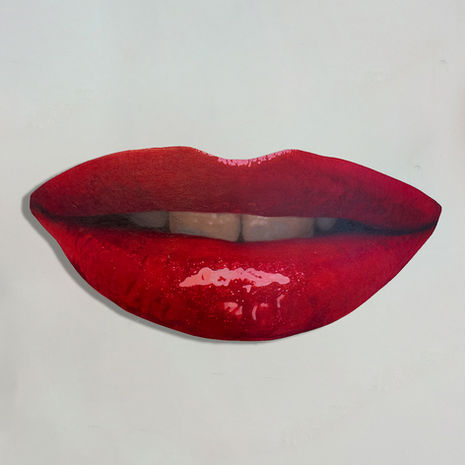
ELSA ERS BROSH | CTRL+ALTAR+DEL
CTRL+ALTAR+DEL | 29 MAY - 7 JULY 2025
In her latest series of paintings, exhibited for the first time in Tel Aviv in her solo exhibition 'CTRL+ALTAR+DEL', Turkish-Israeli artist Elsa Ers Brosh delves into her personal exploration of life in the 21st century, focusing on cultural hybridity and post-digital society — where the boundaries between reality and the digital realm blur.
Brosh’s personal journey is deeply intertwined with her artistic vision. Born in Istanbul to a multicultural Jewish family, Brosh’s personal journey — marked by feelings of displacement and a plural identity — deeply informs her art. Her move to the West during her studies revealed the strength of her Middle Eastern roots, sparking a reflection on identity, belonging, and the impact of digital culture. This journey of self-discovery and belonging is reflected in her art, as she explores the universal quest for identity and connection in a world increasingly defined by digital interactions, focusing on the interplay between the pursuit of meaning in both digital and natural realms.
As she investigates the cycle of seeking, consumption, and the addiction to attention as a means of feeling whole, Brosh also unveils a profound conflict within the human psyche. The pursuit of idealism and perfection — idolizing digital personas and emulating an unsustainable, unreal existence — emerges as a recurring theme. The ego, fragile by nature, becomes easily fractured through the screen. Using both digital imagery and real balloons as figurative objects, Brosh confronts her own contradictions and anxieties, telling the story of Homo Digitalis — a possible next step in human evolution. This concept symbolizes the integration of technology into our very being, transforming us into hybrid entities, both human and digital. This evolution is not only about the tools we use but about how they redefine our sense of self and place in the world.
Having witnessed the rise of social media as it rewired perception, Brosh positions herself as both chronicler and participant in this transformation. Her hyper-realistic paintings invite us in — not as voyeurs, but as reflections — asking: Who are we when the mirror no longer shows the truth? Can we return to ourselves after a thousand filters?
Yet her inquiry stretches beyond the digital. Shaped by displacement and a plural sense of self, Brosh’s journey — from Istanbul to the West, and then back East to Israel — infuses her work with a search for wholeness. Her works serve as a tragicomic warning, urging us to reconsider our relationship with technology, the relentless pursuit of fulfillment in the digital age, and the ways these forces shape our identity. Brosh’s visual narrative captures this transformation by portraying the digital and physical worlds as intertwined. She invites viewers to contemplate what it means to be human in an age where technology is becoming integral to our everyday existence.
The subjects of cultural hybridity and the digital-analog divide have been also addressed by other contemporary Israeli artists through different mediums. Contemporary video and new media artist Nevet Yitzhak has digitally manipulated archival footage and traditional artifacts, remixing them into immersive installations. Others such as Eyal Gever, fuse code with physical art to create digital sculptures, which were produced as 3D printed sculptures in space. Brosh's approach focus on digital and cultural hybridity by reflecting her personal experience, transforming her own disruptive digital habits and cultural alienation into creative expression.
Emerging from a period marked by a global pandemic and then wartimes in which people worldwide, especially Jews in Israel and the diaspora, experienced profound alienation — Brosh turned to social media in an increasingly obsessive way. Whether searching for answers or for a sense of community, she spent countless hours chasing something that could not be found online. Her work is the result of what she absorbed, witnessed, and internalized during that time.
Inspired by AI-generated imagery, Brosh paints anthropomorphized balloon characters — much like people craft avatars and online personas. The balloons are painted in various states of inflation and deflation, to symbolize the fragility and impermanence of identity in the digital age. They evoke the ephemeral nature of online personas and the constant craving for validation through likes and followers. Much like emojis serve as shorthand for human emotion, her balloon figures are humorous tributes to our longing for connection.
In several paintings, traditional Turkish visual motifs subtly appear — hidden in backgrounds, embedded in textures, or folded into details only visible upon close inspection. These symbols act as whispered reminders of the artist’s cultural roots. Discreet yet persistent, they mirror the way memory lingers beneath layers of reinvention, embodying Brosh’s experience of carrying a heritage that is quiet, yet ever-present.
Through her use of traditional figurative painting and glazing techniques, Brosh crafts a hybrid visual language — both deeply personal and universally relevant. Her surrealist approach offers a satirical reflection on how technology reshapes our inner lives.
By combining real and digital elements, her visual language appears both familiar and alien — mirroring the hybrid nature of modern existence. Brosh’s artistic vision is a testament to her unique perspective, shaped by her multicultural background and her lived experiences navigating diverse cultural landscapes. Her paintings are not only a reflection of the digital era but also a deeply personal exploration of identity, belonging, and the human condition.
INSTALLATION VIEWS

WORKS












































